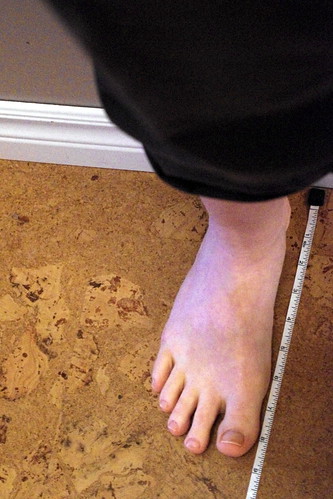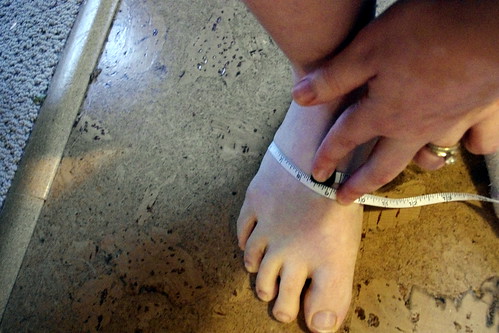So Catt has asked for tips on how to measure feet for knitting socks. I am by no means an expert, but I figured I'd share what works for me in hopes that it helps a bit. I mostly knit socks using the methods from Cat Bordhi's New Pathways for Sock Knitters, and have found these socks fit me and most of my family really well. So I take my measurements based on these patterns--and that means the way I do it might not translate perfectly to every other type of pattern out there. But in case you find it helpful, here it goes (apologies for subjecting you to my feet. And I didn't even get a manicure for you!):
1. Foot Length. When I first started knitting socks, I made the mistake of just measuring my foot at rest. I've since learned that it works better to measure the foot while standing, so it's weight-bearing at stretch out a bit. The best way to do this is to put your ruler or tape measure against the wall and stand right beside it, with your heel against the wall:

You'll notice that my tape measure (like most) has a little tab at the back before the measuring part starts. This means that I'll need to subtract the length of that section from my total measurement. For this reason, a ruler often works better than a tape measure for this.
2. Foot circumference. Most people's feet are not the same circumference all around. It's wider at the ball, narrows a bit, and then because of your arch it widens again. However, the knit fabric of your socks will stretch and shift a bit to conform to some of these changes, so you should figure out your circumference at a midpoint--after the ball of your foot, but before the top of the arch:

3. Other variables. For most people, and most socks, I find these 2 numbers to be enough. However, there could be special cases:
-knee socks: if the socks are going up very high, the wearer's leg likely widens and the sock will need to grow to accommodate this. I don't have a lot of experience in this area, but I'd suggest measuring the leg circumference every 2 inches or so to see how big it's getting and increase accordingly.
-ankle size: some people have skinny ankles, some people have chunkier ankles. Nothing wrong with either, but it will impact the fit of your socks. If your ankles are thinner than the width of your foot will suggest, some decreases will need to happen in the sock cuff or it won't stay up. And if your ankles are larger, increases will be necessary to be able to get the sock up.
-high or low arches: again, not my area of expertise. But if your arch height is much outside the norm (and I think you'd probably know this from experience shoe shopping?), the increases you need to do for an arch expansion will change.
4. Gauge. I'm not a big fan of swatching for socks, so often what I'll do is take a guess at how many stitches I need, cast on for a toe (I knit toe up more frequently, although not always), and start knitting. When I have about 2 inches, I measure. This way, if I have a good gauge I'm already into my sock. And if I'm off, I'm no worse off than if I'd knit a swatch anyway, really. Many people get a different gauge in the round, and a different gauge from DPNs to circs, so it really does help to swatch in the round on the type of needles you plan to use. Also, I recommend determining both stitches per inch (spi) and rows per inch (rpi).
OK, now you need to know how to USE those numbers to make your socks fit, right? Well, I'm tired, so you'll have to wait for part 2! Or you could go buy Cat Bordhi's book, I think she explains it better than I could anyway.
1. Foot Length. When I first started knitting socks, I made the mistake of just measuring my foot at rest. I've since learned that it works better to measure the foot while standing, so it's weight-bearing at stretch out a bit. The best way to do this is to put your ruler or tape measure against the wall and stand right beside it, with your heel against the wall:

You'll notice that my tape measure (like most) has a little tab at the back before the measuring part starts. This means that I'll need to subtract the length of that section from my total measurement. For this reason, a ruler often works better than a tape measure for this.
2. Foot circumference. Most people's feet are not the same circumference all around. It's wider at the ball, narrows a bit, and then because of your arch it widens again. However, the knit fabric of your socks will stretch and shift a bit to conform to some of these changes, so you should figure out your circumference at a midpoint--after the ball of your foot, but before the top of the arch:

3. Other variables. For most people, and most socks, I find these 2 numbers to be enough. However, there could be special cases:
-knee socks: if the socks are going up very high, the wearer's leg likely widens and the sock will need to grow to accommodate this. I don't have a lot of experience in this area, but I'd suggest measuring the leg circumference every 2 inches or so to see how big it's getting and increase accordingly.
-ankle size: some people have skinny ankles, some people have chunkier ankles. Nothing wrong with either, but it will impact the fit of your socks. If your ankles are thinner than the width of your foot will suggest, some decreases will need to happen in the sock cuff or it won't stay up. And if your ankles are larger, increases will be necessary to be able to get the sock up.
-high or low arches: again, not my area of expertise. But if your arch height is much outside the norm (and I think you'd probably know this from experience shoe shopping?), the increases you need to do for an arch expansion will change.
4. Gauge. I'm not a big fan of swatching for socks, so often what I'll do is take a guess at how many stitches I need, cast on for a toe (I knit toe up more frequently, although not always), and start knitting. When I have about 2 inches, I measure. This way, if I have a good gauge I'm already into my sock. And if I'm off, I'm no worse off than if I'd knit a swatch anyway, really. Many people get a different gauge in the round, and a different gauge from DPNs to circs, so it really does help to swatch in the round on the type of needles you plan to use. Also, I recommend determining both stitches per inch (spi) and rows per inch (rpi).
OK, now you need to know how to USE those numbers to make your socks fit, right? Well, I'm tired, so you'll have to wait for part 2! Or you could go buy Cat Bordhi's book, I think she explains it better than I could anyway.
Comments